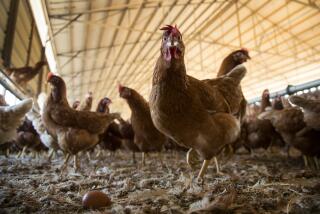Salmonella Silencing Eastern Songbirds
- Share via
INLET, N.Y. — Ida Winter has been feeding the birds for as long as she can remember, and she can never remember anything like this.
Out of the blue, tiny redpolls began dying all around the dozen bird feeders Winter keeps in her backyard near this Adirondack Mountain hamlet.
“I watched one day,” she said. “They would get all fluffed-up like they were cold, and they were very weak. They couldn’t always get on the feeders, so they’d just feed off the ground.
“All seemed like their necks were broken. They couldn’t hold their heads up. I was surprised,” Winter said. “I have seen hawks take birds in flight, but I had never seen any birds die from this source. I thought it was something I did.”
It wasn’t.
A decade after a major outbreak of salmonellosis was reported in songbirds in the Northeast, another wave has hit. It has affected several species, including redpolls, pine siskins, red crossbills and American goldfinches, according to Margaret Barker of Project Feeder Watch at Cornell University’s ornithology lab.
Although scientists say the outbreak appears to be on the wane, dead songbirds have been confirmed in 11 states in the East and Midwest, and birds from four other states are being examined, said Dr. Kim Miller, a wildlife disease specialist at the National Wildlife Health Center in Madison, Wis.
“Salmonellosis in itself is a very common finding in songbirds,” Miller said. “It’s a common cause of songbird mortality. The thing that’s a little bit different is having multiple states reporting mortality all at about the same time. It’s something we usually don’t see in the eastern half of the country.”
Miller said die-offs caused by salmonellosis are common in the West, occurring every two or three years, but she said scientists really don’t know why. It’s not known just how bad the outbreak in the East has been, Miller said.
In New York, the disease has been killing songbirds across the state since at least January, according to pathologist Ward Stone of the New York State Department of Environmental Conservation.
“It’s certainly in the thousands in New York state alone,” Stone said. “We only see a small number. It started first in the pine siskins in Ulster County, and that tells you something because that’s at the bottom of the state [in the Hudson River Valley]. That means it was going on in other places. We just didn’t have any birds.”
That was until bird lovers like Winter began sending carcasses to Stone, who determined that salmonella was to blame.
Tests are under way at the U.S. Department of Agriculture’s National Veterinary Services Laboratory in Ames, Iowa, to identify the salmonella that’s doing the damage.
There’s a lot to sift through. There are more than 2,000 possible strains of the disease, and birds frequently carry one or more forms of it without getting sick, unless their immune systems are stressed or a virulent strain comes along.
Many birds become sick only if under stress. One cause of stress could be unaccustomed, long-distance flights to the United States by birds that normally winter in Canada.
“Whenever the birds come down [from Canada] is when they have a shortage of food,” Stone said. “Something happens that they don’t get enough food, and they come south looking for more. They come down periodically. It’s always weather-related one way or another.”
Like most bacteria, salmonella thrives in warm, wet conditions, and so the unusually mild winter in the Northeast--another El Nino effect?--has been raised as a possible cause.
“It’s certainly correlated with it, but correlated isn’t necessarily causation,” Stone said.
The disease is transmitted by infected fecal matter and probably occurs when species gather in barnyards, woods or fields. Infected birds can remain healthy even as they pass along the disease.
“We’re starting to get information in about cats that are catching sick birds, getting sick and then people handling either sick birds or their sick cats getting infected,” said Patrick McDonough, a bacteriologist at the Cornell bird lab. “This thing is going to spread out like a ripple effect. Whenever there’s a pandemic in a wildlife reservoir that’s in contact with either people or domestic animals, you always have that potential,” he said.
Winter certainly doesn’t want to hear that, especially now that spring is about to bloom in the mountains.
“I’m so worried about my chickadees ‘cause they’re my favorites,” she said. “They’re such sweet little things, such gentlemen. They take one seed at a time, where these other finches just sit and pick, pick, pick.”
More to Read
Sign up for Essential California
The most important California stories and recommendations in your inbox every morning.
You may occasionally receive promotional content from the Los Angeles Times.










